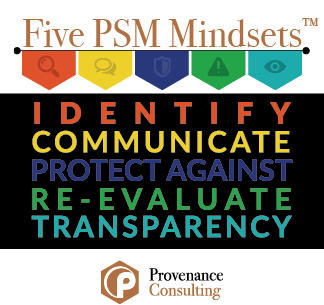Crisis Operations: Is Your PSM Program at Risk? [Webinar]
Specifically, have these deviations in day-to-day operations created more risks to your PSM program?Read more
Specifically, have these deviations in day-to-day operations created more risks to your PSM program?Read more
In Bloom’s Taxonomy, “evaluation” is the fifth of six levels. Learners progress from remembering, to understanding, to applying, analyzing and then evaluating and finally creating.
One of the most important “evaluating” exercises in Process Safety Management (PSM) is the Process Hazard Analysis (PHA).
In a PHA, a group of people with expertise in the process (operators, engineers, etc.) gather to look at all the equipment and chemistry and technology involved.
They detail out each possible hazard, cause, consequence and safeguard. They review the risks, make recommendations, and put all of this information into a report.
When you re-evaluate something, it’s typically done with an eye towards any changes or new information.
In PSM, we re-evaluate the hazards when we make a change through the management of change (MOC) process or when there has been an incident and we want to see what went wrong and if we missed something in the first evaluation of the hazard.
When you want to evaluate something again, it would seem natural to look at the original evaluation.
In significant incident investigations, the PHA report is often pulled up to determine if something was missed or a recommendation wasn’t completed.
But during the course of an MOC, it is very rare for the original PHA to be referenced.
Even if the project involves significant change and generates its own PHA, it is not always standard practice to reference the original unit PHA.
One reason for this is the great complexity of the information in a PHA and the challenges in finding a specific area.
In short, the PHA details aren’t always easily accessible.
And as I said, it’s not a standard practice. Most MOC procedures I’m familiar with do not include a checkbox for looking at the original PHA.
In my many years as a process engineer, I was never advised to look at the PHA for the unit when doing a change. We simply did our own mini-PHA with the group of engineers and operators on hand.
But what about the great level of time and expertise that had already been invested in the most recent PHA? What if something we changed had been counted on for a safeguard? Maybe we caught it in our project group, but what if we didn’t?
There are many advantages to making PHA results and comments more structured and searchable.
One of those is the opportunity for engineers and operators to easily reference nodes and sections of a unit and review the hazards when a change is being proposed and reviewed.
It is one more way we can all have the best information on hand to make wise and safe decisions.
Our Managing Partner Patrick Nonhof presented a webinar on “Can PHA Be Big Data”. He discusses applicable, practical ways to make your PHA data more useful by addressing the barriers to its usability – lack of structure and lack of accessibility. The possibilities for data analysis and continual value-add on your PHA data is an untapped resource at many facilities. Let us help you realize that potential.

In Star Trek, the ship is protected by a force field called a “shield”. When under attack, the tactical officer will call out the status of the shield’s integrity, e.g. “shields at 70%, Captain.” When shields are down to 10%, you know that a breach is imminent unless they retreat or find a way to defeat their attacker.
In a refinery or chemical plant, there is no one calling out the integrity of our protection systems and procedures every few minutes.
But OSHA has specified three specific process safety elements that are critical to Protect Against the Hazards (one of the Five PSM Mindets™) – Pre-Startup Safety Reviews, Mechanical Integrity, and Hot Work Permits.
Once we’ve identified the hazards, it’s time to do something about it. We’ve seen where danger may strike, so we go to the possible sources. We anticipate what could go wrong and prepare for it.
In a process hazard analysis (PHA), safeguards and layers of protection are identified and counted on. And in our industry, there is a great deal of focus on mechanical integrity and maintaining safety instrumented systems.
In a successful process safety culture, the success or failure of the facility is the responsibility of everyone together – like the crew on Star Trek.
If you are going to help ensure the shields are at maximum strength, here are a few places to start:
The safety of a star ship isn’t just dependent on its shield. It depends upon each crew member doing their part and working as a team.
The safety of a facility isn’t just based on the safeguards put in place, but upon each person inside the gate doing their part.
You are more than helping maintain the “shield” – YOU are an integral part of the shield preventing catastrophe so that we may all “live long and prosper”.
